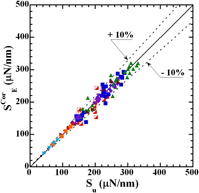Crossref Citations
This article has been cited by the following publications. This list is generated based on data provided by
Crossref.
Jha, Kaushal K
Zhang, Shuo
Suksawang, Nakin
Wang, Ton-Lo
and
Agarwal, Arvind
2013.
Work-of-indentation as a means to characterize indenter geometry and load–displacement response of a material.
Journal of Physics D: Applied Physics,
Vol. 46,
Issue. 41,
p.
415501.
Martinez, Ricardo
and
Xu, L. Roy
2014.
Comparison of the Young’s moduli of polymers measured from nanoindentation and bending experiments.
MRS Communications,
Vol. 4,
Issue. 3,
p.
89.
Jha, Kaushal K.
Suksawang, Nakin
and
Agarwal, Arvind
2014.
A new insight into the work-of-indentation approach used in the evaluation of material’s hardness from nanoindentation measurement with Berkovich indenter.
Computational Materials Science,
Vol. 85,
Issue. ,
p.
32.
Zhang, Jing
Wang, Chunbao
Yang, Fan
and
Du, Chang
2014.
Nanoindentation creep behavior of enamel biological nanocomposites.
RSC Adv.,
Vol. 4,
Issue. 77,
p.
41003.
Jha, Kaushal K.
Suksawang, Nakin
Lahiri, Debrupa
and
Agarwal, Arvind
2015.
A novel energy-based method to evaluate indentation modulus and hardness of cementitious materials from nanoindentation load–displacement data.
Materials and Structures,
Vol. 48,
Issue. 9,
p.
2915.
Jha, K.
Suksawang, N.
and
Agarwal, A.
2015.
Determination of Nanomechanical Properties of Cementitious Materials Using an Energy-Based Approach.
p.
908.
Milman, Yu. V.
Chugunova, S. I.
Goncharova, I. V.
and
Golubenko, А. А.
2018.
Plasticity of Materials Determined by the Indentation Method.
Uspehi Fiziki Metallov,
Vol. 19,
Issue. 3,
p.
271.
Xu, L. Roy
Martinez, Ricardo
and
Zhao, Kai
2019.
Measurements of Through-Thickness Young's Moduli of Fibrous Composite Laminates Using Nanoindentation.
Journal of Engineering Materials and Technology,
Vol. 141,
Issue. 3,
Contreras Romero, Elbert
Hurtado Macías, Abel
Méndez Nonell, Juan
Solís Canto, Oscar
and
Gómez Botero, Maryory
2019.
Mechanical and tribological properties of nanostructured TiAlN/TaN coatings deposited by DC magnetron sputtering.
Surface and Coatings Technology,
Vol. 378,
Issue. ,
p.
124941.
Xu, Shilang
Feng, Ying
Liu, Jiahan
and
Zeng, Qiang
2020.
Micro indentation fracture of cement paste assessed by energy-based method: The method improvement and affecting factors.
Construction and Building Materials,
Vol. 231,
Issue. ,
p.
117136.
Hasiak, Mariusz
Sobieszczańska, Beata
Łaszcz, Amadeusz
Biały, Michał
Chęcmanowski, Jacek
Zatoński, Tomasz
Bożemska, Edyta
and
Wawrzyńska, Magdalena
2021.
Production, Mechanical Properties and Biomedical Characterization of ZrTi-Based Bulk Metallic Glasses in Comparison with 316L Stainless Steel and Ti6Al4V Alloy.
Materials,
Vol. 15,
Issue. 1,
p.
252.
Ma, Zhaoyang
Gamage, Ranjith Pathegama
and
Zhang, Chengpeng
2021.
Mechanical properties of α-quartz using nanoindentation tests and molecular dynamics simulations.
International Journal of Rock Mechanics and Mining Sciences,
Vol. 147,
Issue. ,
p.
104878.
Jain, Abhilasha
Prabhu, Yogesh
Gunderov, Dmitry
Narayan, R. Lakshmi
Saini, Priyanka
Vincent, S.
Sudha, Priya
Bagde, Ashutosh D.
and
Bhatt, Jatin
2022.
Structural characterization, biocorrosion and in-vitro investigation on Zr62Cu22Al10Fe5Dy1 metallic glass for bio-implant applications.
Journal of Non-Crystalline Solids,
Vol. 598,
Issue. ,
p.
121928.
Milman, Yuly V.
Galanov, Boris A.
Goncharuk, Victor
Voskoboinik, Igor V.
and
Goncharova, Irina
2022.
Determination of New Plasticity Characteristic of Alloys at Mechanical Compression and Tensile Tests and the Influence of Structural Factors on Plasticity.
Solid State Phenomena,
Vol. 331,
Issue. ,
p.
11.
Liu, Cuicui
Peng, Jian
Xu, Zhigang
Shen, Qiang
and
Wang, Chuanbin
2023.
Combined Effect of Substrate Temperature and Sputtering Power on Phase Evolution and Mechanical Properties of Ta Hard Coatings.
Metals,
Vol. 13,
Issue. 3,
p.
583.
Zhang, Pengyu
Zhang, Dongxiao
and
Zhao, Junliang
2024.
Control of fracture toughness of kerogen on artificially-matured shale samples: An energy-based nanoindentation analysis.
Gas Science and Engineering,
Vol. 124,
Issue. ,
p.
205266.
Umoh, G V
Gómez-Ovalle, A E
Cruz, M P
Leal-Pérez, J E
Obot, Okure U
Berrio, Héctor Urzola
Herrera-Basurto, Raúl
Mercader-Trejo, F
and
Hurtado-Macias, A
2024.
Nanomechanical-ferroelastics behavior, and the low-temperature ferroelectric manifestation of BiMnO3 thin films.
Physica Scripta,
Vol. 99,
Issue. 3,
p.
035962.





